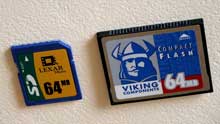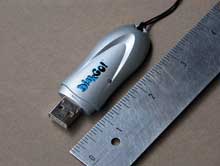Storage Devices
Links to topics on this page:
Storage devices, such as disk drives, store your documents (data files) and programs (executable files) when they are not currently in use for processing. Unlike the contents of RAM, the data stored on these devices does not vanish when power is turned off.
The major categories of storage devices are magnetic, solid state, and optical.
Hard Disk Drive
Hard Disk
Floppy
Diskette
Zip Disk
Flash Drive
CD
DVD
A hard disk drive contains disks made of metal and coated with a metal oxide that can be magnetized. A tiny electromagnetic read/write head on the end of a seek arm magnetizes tiny spots on the disk to store data. Magnetic spots magnetized in one direction represent a one; spots magnetized in the opposite direction represent a zero (OK, I simplified things a little, but you get the idea). The same electromagnetic head can later sense the magnetic fields of the spots as they pass underneath the head, allowing the data to be read back from the disk.
Hard drives are rated by their storage capacity, typically tens or hundreds of gigabytes. They are also rated by how fast the disks spin (in rpm, rotations per minute), which is typically thousands of rpm. Another way to rate a hard disk is by average access time (measured in milliseconds, ms), which tells on average how long it would take the drive to retrieve any bit of data from the disk. Typical seek times are around 6 ms.
The electronics that control the hard disk often incorporate some cache memory. The drive reads in several sectors of data instead of just one—that way, if the CPU happens to request those next sectors, the drive can send them immediately without having to wait for the disk to rotate back around again.
The controller electronics for a hard drive may be IDE, or ATA, or SCSI, or something else. Don’t worry about this detail here, but you do need to get the right kind to go into your computer if you want to add additional drives. You can also plug additional hard drives externally into the USB or Firewire ports of a computer, if desired.
Floppy Diskette
Hard Disk
(click for larger image)
In a floppy diskette the disk is made of flexible mylar plastic coated with metal oxide that can be magnetized. Floppy diskettes are 3.5" in size (older style floppy diskettes for early PCs were 5.25").
A shutter protects the disk surface from dirt and fingerprints; the shutter slides out of the way when the disk is inserted into the drive so that the read/write heads can reach the disk.
A small plastic slider can be slid to unblock a hole in the corner of the diskette to write-protect the disk (so data can’t be accidentally erased).
High-density floppy diskettes hold 1.44 MB. The access time is much slower than for a hard disk, and they are somewhat unreliable. Many new computers don’t have a floppy drive, but you can purchase an external drive to plug in if you need to.
Zip Disk
Floppy Diskette (1.44 MB)
(click for larger image)
A Zip disk is similar in size to a floppy diskette, but thicker. It is basically a “super floppy” but the higher construction tolerances and smaller read/write heads allow the Zip disk to hold more data than a floppy. The first Zip disks held 100 MB. Later Zip drives could read 250 MB Zips (in addition to the old 100 MB disks). An even newer model Zip drive uses 750 MB disks.
Both Zip disk and floppy diskettes have the advantage of being removable media. Data stored on these disks can be removed and taken to other locations. Both Zips and floppies can be formatted for either the PC or the Macintosh (Macs can read both formats).
We had Zip drives in our previous PCs and Macs at UNM-LA, but our newer computers don't use these, so you may never have to deal with them.
Flash Drive

Zip Disk (250 MB)
A USB Flash Drive is a portable solid state memory device that plugs into a USB port on your computer. They have many other names (such as key drive, pocket drive, thumb drive, pen drive). They have replaced floppy diskettes and Zip disks at UNM-LA as our preferred means to carry files around. They work on both Macs and PCs.
These small drives store data on flash memory microchips (a kind of EEPROM). Flash memory can be erased and re-written a limited number of times (typically many thousands of times). Some units have a write-protect switch.
The storage capacity varies, but anything from 16 MB to over a gigabyte are available.
Flash Memory Cards
USB Flash Drive
(click for larger image)
The same kind of flash memory used in the USB flash drives above are is used in small memory cards (a Secure Data SD card, and a Compact Flash card are shown on the right). These cards are used by PDAs, digital cameras, MP3 music players, and other digital devices. You can attach a flash memory card reader to your computer to read and write data to these cards as well. These memory cards (and other types not shown here) come in a variety of storage capacities from tens of megabytes to over a gigabyte.
CD-ROM

Example Flash Memory cards (SD card left, Compact Flash card right)
A CD-ROM (Compact Disc Read Only Memory) is an optical storage medium that can hold about 670MB. “Optical” means that light is used to read the data from the disk (it is not a magnetic medium). CD-ROMs are very cheap to produce in large quantities, so most software is distributed on CD-ROMs.
Data is stored on a CD-ROM as small pits in the plastic of an inner layer, which is then aluminized and overcoated with another clear layer. A laser beam inside the CD-ROM drive is bounced off the disk and the sequences of pits and not-pits (the reflectivity is different) is converted into the ones and zeros of the data.
CD-ROM drives are rated by speed, such as 32x, which means 32 times faster than the first CD-ROM drives.
CD-R and CD-RW

CD-ROM disc
CD-R (Compact Disc - Recordable) and CD-RW (Compact Disk - ReWritable) are CDs that can be written to (if your computer has a CD-RW drive).
The CD-R discs have a layer of dye that is changed by a higher power laser in the drive to record data (the low power reading laser does not change the data). The CD-R can only have its data surface changed ONCE at each spot (although you can write multiple sessions to one disk until it is full). After that, it is read-only. CD-Rs can hold 700 MB of data.
The CD-RW discs contain a phase-change material that different power laser beams can read, write, and erase, so these disks can be used many times (but must be erased before re-writing).
DVD
DVD-ROM discs (DVD = Digital Versatile Disc) are optical storage media similar to CD-ROMs, but with a higher storage capacity. DVDs use smaller spots to record data, and the disks can be dual-layer and double-sided, with each layer holding 4.7 GB of data (so a dual-layer/double-sided DVD can hold 18 GB of data).
Like CDs, DVDs also have recordable variants, although there are still multiple formats (DVD-R and DVD+R) competing for dominance. A single-layer DVD-R can hold 4.7 GB of data (Dual Layer discs can hold twice as much).
DVD drive speeds are rated in terms of how many times faster that the original DVD drives they are (a 6x DVD drive is 6 times faster)


